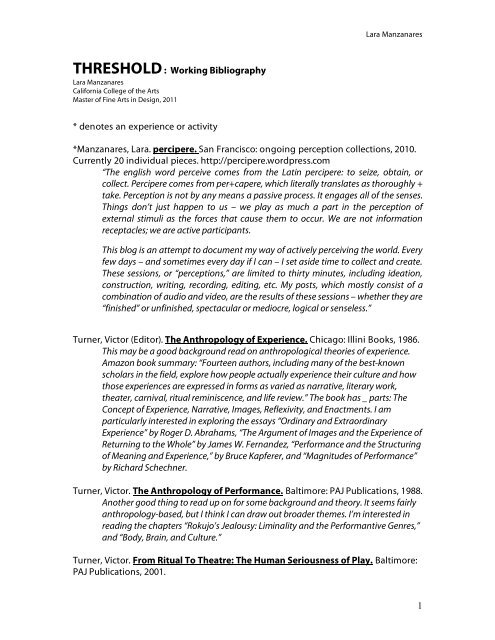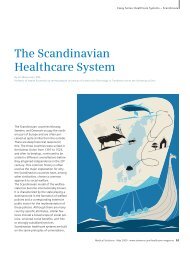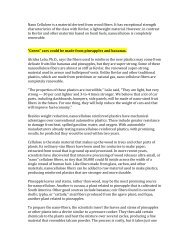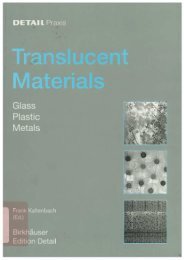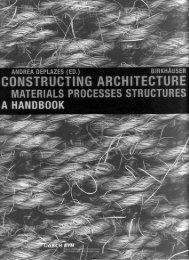Download text-only Bibliography - California College of the Arts
Download text-only Bibliography - California College of the Arts
Download text-only Bibliography - California College of the Arts
You also want an ePaper? Increase the reach of your titles
YUMPU automatically turns print PDFs into web optimized ePapers that Google loves.
Lara Manzanares<br />
THRESHOLD : Working <strong>Bibliography</strong><br />
Lara Manzanares<br />
<strong>California</strong> <strong>College</strong> <strong>of</strong> <strong>the</strong> <strong>Arts</strong><br />
Master <strong>of</strong> Fine <strong>Arts</strong> in Design, 2011<br />
* denotes an experience or activity<br />
*Manzanares, Lara. percipere. San Francisco: ongoing perception collections, 2010.<br />
Currently 20 individual pieces. http://percipere.wordpress.com<br />
“The english word perceive comes from <strong>the</strong> Latin percipere: to seize, obtain, or<br />
collect. Percipere comes from per+capere, which literally translates as thoroughly +<br />
take. Perception is not by any means a passive process. It engages all <strong>of</strong> <strong>the</strong> senses.<br />
Things don’t just happen to us – we play as much a part in <strong>the</strong> perception <strong>of</strong><br />
external stimuli as <strong>the</strong> forces that cause <strong>the</strong>m to occur. We are not information<br />
receptacles; we are active participants.<br />
This blog is an attempt to document my way <strong>of</strong> actively perceiving <strong>the</strong> world. Every<br />
few days – and sometimes every day if I can – I set aside time to collect and create.<br />
These sessions, or “perceptions,” are limited to thirty minutes, including ideation,<br />
construction, writing, recording, editing, etc. My posts, which mostly consist <strong>of</strong> a<br />
combination <strong>of</strong> audio and video, are <strong>the</strong> results <strong>of</strong> <strong>the</strong>se sessions – whe<strong>the</strong>r <strong>the</strong>y are<br />
“finished” or unfinished, spectacular or mediocre, logical or senseless.”<br />
Turner, Victor (Editor). The Anthropology <strong>of</strong> Experience. Chicago: Illini Books, 1986.<br />
This may be a good background read on anthropological <strong>the</strong>ories <strong>of</strong> experience.<br />
Amazon book summary: “Fourteen authors, including many <strong>of</strong> <strong>the</strong> best-known<br />
scholars in <strong>the</strong> field, explore how people actually experience <strong>the</strong>ir culture and how<br />
those experiences are expressed in forms as varied as narrative, literary work,<br />
<strong>the</strong>ater, carnival, ritual reminiscence, and life review.” The book has _ parts: The<br />
Concept <strong>of</strong> Experience, Narrative, Images, Reflexivity, and Enactments. I am<br />
particularly interested in exploring <strong>the</strong> essays “Ordinary and Extraordinary<br />
Experience” by Roger D. Abrahams, “The Argument <strong>of</strong> Images and <strong>the</strong> Experience <strong>of</strong><br />
Returning to <strong>the</strong> Whole” by James W. Fernandez, “Performance and <strong>the</strong> Structuring<br />
<strong>of</strong> Meaning and Experience,” by Bruce Kapferer, and “Magnitudes <strong>of</strong> Performance”<br />
by Richard Schechner.<br />
Turner, Victor. The Anthropology <strong>of</strong> Performance. Baltimore: PAJ Publications, 1988.<br />
Ano<strong>the</strong>r good thing to read up on for some background and <strong>the</strong>ory. It seems fairly<br />
anthropology-based, but I think I can draw out broader <strong>the</strong>mes. I’m interested in<br />
reading <strong>the</strong> chapters “Rokujo’s Jealousy: Liminality and <strong>the</strong> Performantive Genres,”<br />
and “Body, Brain, and Culture.”<br />
Turner, Victor. From Ritual To Theatre: The Human Seriousness <strong>of</strong> Play. Baltimore:<br />
PAJ Publications, 2001.<br />
1
Lara Manzanares<br />
What I’ve read <strong>of</strong> this book so far has helped me vastly in my explanation <strong>of</strong> what<br />
exactly I’m trying to achieve with my work. It explains <strong>the</strong> experience-performance<br />
cycle, and talks about how performance is necessary to “finish” an experience. It<br />
has helped me figure out what exactly I was trying to do when I began my<br />
“percipere” blog, and what I continue to try to do in my current work.<br />
Turner, Victor. The Ritual Process: Structure and Anti-Structure. (place unknown):<br />
Aldine, 1995. (most <strong>of</strong> it available on google books)<br />
Mostly specific to Turner’s time in Africa, this book does however <strong>of</strong>fer a good<br />
explanation <strong>of</strong> liminal space from an anthropological and ritual view.<br />
Patchen, Kenneth. We Meet. New York: New Directions, 2008<br />
(Original publication dates <strong>of</strong> content: 1946, 1957, 1958, 1970)<br />
He usually managed to be <strong>the</strong>re when<br />
He arrived. A horse, his name was<br />
Hunry Fencewaver Walkins—he’d sometimes<br />
Be almost too tired to make it;<br />
Because, since he also hated being alone,<br />
He was always on <strong>the</strong> alert to pop forth<br />
At a full run whenever <strong>the</strong> door opened.<br />
Then one day it happened—<br />
He didn’t get <strong>the</strong>re in time!<br />
Of course he couldn’t risk opening <strong>the</strong> door—<br />
So, panting, he just stood <strong>the</strong>re in <strong>the</strong> hall—<br />
And listened to <strong>the</strong> terrible sound <strong>of</strong> himself weeping<br />
In that room he could never, never enter again.<br />
Kenneth Patchen’s poems don’t “go” anywhere. They hover between <strong>the</strong> beginning<br />
and <strong>the</strong> end. They make no sense, and <strong>the</strong>y make all <strong>the</strong> sense in <strong>the</strong> world.<br />
Brilliant.<br />
Carroll, Lewis. Alice’s Adventures in Wonderland & Through <strong>the</strong> Looking-Glass.<br />
London: Penguin, 1998, (Original publication dates 1865 and 1872, respectively)<br />
This publication serves multiple purposes. It is an example <strong>of</strong> how an author<br />
successfully interprets <strong>the</strong> in, <strong>the</strong> out, and <strong>the</strong> in-between in a time <strong>of</strong> cultural<br />
upheaval (It was first published soon after Charles Darwin’s Theory <strong>of</strong> Evolution)<br />
using wild storytelling. I generally think <strong>of</strong> myself as <strong>the</strong> character Alice, making my<br />
way through spaces and making sense (or nonsense) <strong>of</strong> everything around me.<br />
Hayes, Joe: Retold by. La Llorona / The Weeping Woman. El Paso: Cinco Puntos,<br />
2004.<br />
This story, a traditional Mexican / New Mexican / Latin American ghost story, tells<br />
<strong>of</strong> a woman caught in between life and death. She wanders, like Alice, but not<br />
aimlessly. She is looking for her children, whom she murdered. She is, in effect,<br />
trapped in a drawn-out liminal space, unable to let go <strong>of</strong> <strong>the</strong> time that came before<br />
2
Lara Manzanares<br />
<strong>the</strong> transition away from life. The storytelling style in this and o<strong>the</strong>r ghost stories<br />
warn us away from this frightening in-between space. This story may have<br />
historical ties to <strong>the</strong> story <strong>of</strong> La Malinche – <strong>the</strong> indigenous companion <strong>of</strong> Hernán<br />
Cortés. She is seen as both a traitor and <strong>the</strong> mo<strong>the</strong>r <strong>of</strong> <strong>the</strong> mestizo race, both<br />
revered and despised. La Llorona is also a song, a haunting musical piece that is<br />
tender, vengeful, wistful and exuberant, all at <strong>the</strong> same time.<br />
Derrida, Jacques. The Truth in Painting. Chicago: University <strong>of</strong> Chicago Press, 1987.<br />
“It is finality-without-end which is said to be beautiful (…). So it is <strong>the</strong> without that<br />
counts for beauty; nei<strong>the</strong>r <strong>the</strong> finality nor <strong>the</strong> end, nei<strong>the</strong>r <strong>the</strong> lacking goal nor <strong>the</strong><br />
lack <strong>of</strong> a goal but <strong>the</strong> edging in sans <strong>of</strong> <strong>the</strong> pure cut, <strong>the</strong> sans <strong>of</strong> <strong>the</strong> finality-sansend”<br />
(89).<br />
“From this point <strong>of</strong> view beauty is never seen, nei<strong>the</strong>r in <strong>the</strong> totality nor outside it:<br />
<strong>the</strong> sans is not visible, sensible, perceptible, it does not exist. And yet <strong>the</strong>re is some <strong>of</strong><br />
it and it is beautiful. It gives <strong>the</strong> beautiful” (90).<br />
“A piece <strong>of</strong> waste land has no fixed limit. Without edge, without any border<br />
marking property, without any nondecomposable frame that would not bear<br />
partition. Vague is a movement without its goal, not a movement without goal but<br />
without its goal. Vague beauty, <strong>the</strong> <strong>only</strong> kind that gives rise to an attribution <strong>of</strong><br />
pure beauty, is an indefinite errance, without limit, stretching toward its orient but<br />
cutting itself <strong>of</strong>f from it ra<strong>the</strong>r than depriving itself <strong>of</strong> it, absolutely. It does not<br />
arrive itself at its destination” (92-93).<br />
“Parerga have a thickness, a surface which separates <strong>the</strong>m not <strong>only</strong> (as Kant would<br />
have it) from <strong>the</strong> integral inside, from <strong>the</strong> body proper <strong>of</strong> <strong>the</strong> ergon, but also from<br />
<strong>the</strong> outside, from <strong>the</strong> wall on which <strong>the</strong> painting is hung…” (61).<br />
*Doe, John & Jane. The Doorway. San Francisco: Lara’s U.S. Census Employment,<br />
2010.<br />
Throughout <strong>the</strong> past summer, I worked as an enumerator for <strong>the</strong> 2010 Census. I<br />
spent 20-30 hours a week seeking out and standing in doorways. Occasionally I<br />
was invited inside, o<strong>the</strong>r times I was threatened and verbally abused. As Census<br />
Employees, we were not allowed to set foot through a doorway unless invited in. At<br />
times, however, even my proximity to <strong>the</strong> doorway was enough to cause a resident<br />
to come unhinged. I thought it very interesting that such a seemingly forgotten or<br />
dismissed space, a space without history, a space that people are in every day but<br />
never spend time in - could trigger such strong emotions.<br />
Hayes, Joe (retold by). “El Terrible Tragadabas,” from Tell Me A Cuento / Cuéntame<br />
Un Story. El Paso: Cinco Puntos, 1998.<br />
“El Terrible Tragadabas” is a children’s story with roots in Spain. It tells <strong>of</strong> a monster<br />
(<strong>the</strong> Tragadabas, or glutton) who hides behind <strong>the</strong> door <strong>of</strong> a small town’s general<br />
store. The three main characters take individual trips to <strong>the</strong> general store, knock on<br />
<strong>the</strong> door and have a brief verbal exchange with <strong>the</strong> monster, who warns <strong>the</strong>m not<br />
to open <strong>the</strong> door. They do anyway, and <strong>the</strong> monster jumps out and tries to<br />
swallow <strong>the</strong>m.<br />
3
Lara Manzanares<br />
“The Message <strong>of</strong> <strong>the</strong> Myth.” Moyers: Joseph Campbell and <strong>the</strong> Power <strong>of</strong> Myth.<br />
Prod. Ca<strong>the</strong>rine Tatge. PBS. WNET, New York. 22 May 1988.<br />
While <strong>the</strong> entire Power <strong>of</strong> Myth series is a valuable resource, in this particular<br />
segment Joseph Campbell explores duality in myths and stories. It is a good<br />
reference for how we function and handle transition through stories and rituals.<br />
*Class: “Pure Music.” San Francisco: Zambaleta World Music and Dance School,<br />
2010. Teacher: Gautam Tejas Ganeshan, New Directions in Indian Music<br />
Last semester and this summer, I took three classes in Indian Classical Voice and<br />
“Pure Music” with Gautam. He opened my eyes to a new way <strong>of</strong> looking at music –<br />
he showed how Indian music embraces and uses <strong>the</strong> space in between notes nearly<br />
as much as <strong>the</strong> notes <strong>the</strong>mselves.<br />
Khan, Hazrat Inayat. The Mysticism <strong>of</strong> Sound and Music: The Sufi Teaching <strong>of</strong><br />
Hazrat Inayat Khan. Boston: Shambala, 1991.<br />
It’s difficult to explain this book right now – all I can say really is that when I think<br />
about my past work and try to explain it, all I know is that deep inside it, inside<br />
everything, <strong>the</strong>re is a sort <strong>of</strong> a “buzzzzzzzzz-hummmmmmmm” that emanates<br />
from a deeper place than can be explained. This sound – or ra<strong>the</strong>r, it’s more than a<br />
sound, it’s a vibration – does not <strong>only</strong> apply to myself, but is present in everything<br />
around – <strong>the</strong> harmony <strong>of</strong> all objects, <strong>the</strong> buzz-hum for example, <strong>of</strong> an entire<br />
stadium full <strong>of</strong> people milling around and interacting as viewed from <strong>the</strong> Goodyear<br />
Blimp. I am hoping that reading this book will help me elucidate some <strong>of</strong> <strong>the</strong>se<br />
intuitions and help me explain <strong>the</strong>m more effectively.<br />
Lynch, David. Mulholland Dr. Los Angeles, 2001.<br />
David Lynch’s storytelling style – seemingly random, but primally interconnected –<br />
he tells much more than a story. The crux <strong>of</strong> his piece is in <strong>the</strong> passage that we go<br />
through but that is never explicitly shown in <strong>the</strong> movie. His visuals draw out <strong>the</strong><br />
meta: A doorway that is gone through turns completely black as <strong>the</strong> camera<br />
encounters it, and <strong>the</strong> resulting “emergence” on <strong>the</strong> o<strong>the</strong>r side, is as if we have been<br />
taken through some kind <strong>of</strong> a portal. Doorways are, for Lynch, more than just<br />
doorways.<br />
Sottsass, Ettore. Design Metaphors. Milan: Idea Books, 1987.<br />
Really great, contemplative book. Contains some interesting visualizations in <strong>the</strong><br />
section “Design for <strong>the</strong> destinies <strong>of</strong> man” in particular. Doorways are used as<br />
metaphors for our trek into <strong>the</strong> future . The installations in <strong>the</strong> book use<br />
architectural and design elements comprised mostly <strong>of</strong> fabric and string and places<br />
<strong>the</strong>m in mountains, deserts, etc.<br />
Campbell, Joseph (editor). Man and Transformation: Papers from <strong>the</strong> Eranos<br />
Yearbooks. Princeton: Princeton University Press, 1964.<br />
This may come in handy – not sure yet exactly how-<br />
4
Lara Manzanares<br />
*Manzanares, Lara. Busking. San Francisco: Street Singing by Lara, 2010.<br />
For <strong>the</strong> past ten years, I have played publicly for money at Farmer’s Markets. Within<br />
<strong>the</strong> last year, I have moved my busking practice into <strong>the</strong> streets <strong>of</strong> San Francisco’s<br />
Mission District. I have, in effect, placed myself in what is, for many people, a<br />
transitional space. I interact with people directly in <strong>the</strong> middle <strong>of</strong> <strong>the</strong>ir journey from<br />
one point to ano<strong>the</strong>r: I am <strong>the</strong> soundtrack for a few seconds <strong>of</strong> <strong>the</strong>ir in-between.<br />
Bhabha, Homi. The Location <strong>of</strong> Culture. London: Routledge, 1994.<br />
While this book mainly deals mainly with issues particular to post-colonialism, it<br />
might be an interesting read in order to explore Bhabha’s idea <strong>of</strong> inhabiting liminal<br />
space as a form <strong>of</strong> resistance. Also – we are living in a post-colonial world, and<br />
through this reading I might find ways to expand my explorations outward from<br />
myself and apply <strong>the</strong>m to broader social <strong>the</strong>mes.<br />
*Manzanares, Lara. Form Studio Journal. San Francisco: handwritten journal, 2009.<br />
During explorations for CCA’s Form Studio class in 2009, I kept a journal with<br />
sketches and thoughts inspired by Martin Venezky, and my classmates’ and my<br />
own explorations. This is an invaluable process resource. It contains a wealth <strong>of</strong><br />
ideas which will inform <strong>the</strong> research and development methods <strong>of</strong> my <strong>the</strong>sis<br />
exploration.<br />
*Manzanares, Lara. Essays. San Francisco: song essays presented in a blog, 2009.<br />
http://lmanzanares.blogs.cca.edu/<br />
Like <strong>the</strong> Form Studio Journal, this piece will guide my exploration process and help<br />
me work through difficult spots. When I began this journal, it was a chore. I came<br />
home every day and told myself, “I don’t want to do this, I just want to sing…” And<br />
<strong>the</strong>n I thought, well hey, who says I can’t? At that moment, an entire world <strong>of</strong><br />
possibilities opened up, and <strong>the</strong> results that I produced went well beyond those <strong>of</strong> a<br />
“classroom journal.” I use this as a (much-needed) reminder that I can trust myself.<br />
World Book Encyclopedia. Chicago: World Book, Inc., 1989.<br />
I photocopied a couple <strong>of</strong> images, and looked up <strong>the</strong> definition <strong>of</strong> 'threshold'<br />
Kandinsky, Wassily. Point and Line to Plane. New York: Dover, 1979. ("Originally<br />
published in 1926 as Punkt und Linie zu Flache, <strong>the</strong> ninth in a series <strong>of</strong> fourteen<br />
Bauhaus books edited by Walter Gropius and L. Moholy-Nagy.")<br />
Need to figure out what this guy was up to.<br />
N 70 .K313<br />
Abbott, Edwin A. Flatland: A Romance <strong>of</strong> Many Dimensions. New York: Dover, 1952.<br />
Need to read this, will be a quick read – Interesting way <strong>of</strong> expressing visual<br />
qualities in a spatial and narrative way… brings <strong>the</strong> flat visual into architectural<br />
and temporal headspace. Also related to Kandinsky’s <strong>the</strong>ories as well as Mondrian’s<br />
5
Lara Manzanares<br />
vertical/horizontal treatment <strong>of</strong> lines and finding equilibrium.<br />
Kachurin, Pamela Jill. Soviet Textiles: Designing <strong>the</strong> Modern Utopia. Boston: MFA,<br />
2006.<br />
Not sure about this one yet – Universality <strong>of</strong> <strong>text</strong>iles, weaving / grid pattern relates<br />
to Mondrian’s <strong>the</strong>ories, and <strong>of</strong> course Constructivist “rebuilding.” Interesting to<br />
note: Patterns on <strong>the</strong>se <strong>text</strong>iles are printed on top <strong>of</strong> <strong>the</strong> fabric. What would it mean<br />
to embed <strong>the</strong> pattern into <strong>the</strong> actual weaving <strong>of</strong> it? This may be a stretch, but I’ll<br />
keep this book around for now. May come in handy when developing methods for<br />
<strong>the</strong> actualization <strong>of</strong> graphic representations.<br />
Hirschorn, Thomas. Utopia, Utopia = One World, One War, One Army, One Dress.<br />
Boston, San Francisco: Institute <strong>of</strong> Contemporary Art (Boston); CCA Wattis Institute<br />
for Contemporary <strong>Arts</strong>, 2005. (Part <strong>of</strong> an exhibition by <strong>the</strong> same name)<br />
Have not read yet – Contains some interesting pieces about <strong>the</strong> prevalence <strong>of</strong><br />
camouflage clothing – camouflage as <strong>the</strong> syn<strong>the</strong>sis <strong>of</strong> figure/ground, universal<br />
equilibrium…<br />
Rotzler, Willy. Constructive Concepts: A History <strong>of</strong> Constructive Art from Cubism<br />
to <strong>the</strong> Present. New York: Rizzoli, 1989.<br />
Photocopied some images from this book. May re-visit for fur<strong>the</strong>r research<br />
Cirlot, J.E. A Dictionary <strong>of</strong> Symbols. London: Routledge 1962.<br />
Looked up threshold.<br />
Cabarga, Leslie. Advertising Spot Illustrations <strong>of</strong> <strong>the</strong> Twenties and Thirties: 1,593<br />
Cuts. New York: Dover, 1989.<br />
Photocopied several pages for past image research<br />
Schaer, Roland; Claeys, Gergory; Sargent, Lyman Tower. Utopia: The Search for <strong>the</strong><br />
Ideal Society in <strong>the</strong> Western World. New York: Oxford, 2000.<br />
Good look into <strong>the</strong> past. Pp. 278 - 297, 316-331.<br />
HX 806 .U7918<br />
Zegher, Ca<strong>the</strong>rine; Krauss, Rosalind; Buchloh, Benjamin; Coessens, Piet; Borja-Villel,<br />
Manuel J.; Chevrier, Jean-Francois. Art and Utopia: Limited Action. Barcelona:<br />
Museu d’Art Contemporani de Barcelona, 2005. (Catalog for a show <strong>of</strong> <strong>the</strong> same<br />
name.)<br />
Excellent visual resource. Comprehensive catalog <strong>of</strong> modern curated toward an<br />
exploration <strong>of</strong> ideas <strong>of</strong> utopia, along with quotes from artists.<br />
Weinhart, Martina; Hollein, Max (editors). Nichts / Nothing. Exhibition Catalogue:<br />
Nichts / Nothing, Schirn Kunsthalle Frankfurt: published by Katje Catz Verlag, 2006.<br />
Have not looked at yet<br />
N 6494 .C93 N53<br />
6
Lara Manzanares<br />
Virilio, Paul. Speed and Politics: An Essay on Dromology. Paris: Semio<strong>text</strong>(e), 1977<br />
(original French), 2006 (English translation).<br />
Need need need to read this<br />
Foster, Hal; Krauss, Rosalind; Bois, Yve-Alain, Buchloh, Benjamin. Art Since 1900:<br />
Modernism, Antimodernism, Postmodernism. New York: Thames & Hudson, 2005.<br />
Reading this book was ano<strong>the</strong>r breakthrough moment – too much to write now –<br />
Harrison, Charles and Wood, Paul. Art in Theory: 1900-2000. Malden,<br />
Massachusetts: Blackwell, 2003.<br />
Great resource to read essays and writings directly from <strong>the</strong> artists <strong>of</strong> modernism.<br />
Ferrier, Jean-Louis. Art <strong>of</strong> <strong>the</strong> 20th Century: The History <strong>of</strong> Art Year by Year from<br />
1900 to 1999: Painting, Sculpture, Architecture. Turin: Chene-Hachette, 1999.<br />
Photocopied some images from this as well as a Kandinsky essay about painting<br />
and music.<br />
Man, Felix H. 8 European Artists. London: Heinemann, 1954.<br />
Picasso's alphabet<br />
Hughes, Robert. The Shock <strong>of</strong> <strong>the</strong> New: The Hundred-Year History <strong>of</strong> Modern Art -<br />
Its Rise Its Dazzling Achievement, Its Fall. New York: Alfred A. Knopf, Inc., 1991.<br />
Good modern art source, to be used along with art since 1900.<br />
N 6447 .H84<br />
Dabrowski, Magdalena. Contrasts <strong>of</strong> Form: Geometric Abstract Art 1910-1980.<br />
New York: Museum <strong>of</strong> Modern Art, 1985.<br />
Pictures <strong>of</strong> constructivist artwork, some essays that looked valuable but have not<br />
read yet.<br />
Traum & Trauma / Dream & Trauma: Works from <strong>the</strong> Dakis Joannou Collection,<br />
A<strong>the</strong>ns. Wien: Hatje Cantz, 2007.<br />
Good to look at to see contemporary artists and how <strong>the</strong>y're dealing with this.<br />
Double-check at <strong>the</strong> library for citation, it's in german and is confusing.<br />
N 6488.5 .J63 T73<br />
Rossington, Michael; Whitehead, Anne (editors). Theories <strong>of</strong> Memory: A Reader.<br />
Baltimore: Johns Hopkins, 2007.<br />
Haven't read yet. Some <strong>of</strong> <strong>the</strong>se essays may be useful.<br />
Grad Design Library<br />
Stein, R. Conrad. The Mexican Revolution: 1910 - 1920. New York: Macmillan, 1994.<br />
Pictures <strong>of</strong> some revolution photos + art as an example <strong>of</strong> trauma or turmoil as a<br />
catalyst to creativity; surrealism <strong>of</strong> Mexican woodcuts and calaveras<br />
7
Lara Manzanares<br />
Barck Jr., Oscar Theodore; Blake, Nelson Manfred. Since 1900: A History <strong>of</strong> <strong>the</strong><br />
United State In Our Times. New York: Macmillan, 1974.<br />
Political cartoons from 1910-1930 or so capture <strong>the</strong> spirit <strong>of</strong> <strong>the</strong> times…<br />
Scherman, David E. (editor). Life Goes to War: A Picture History <strong>of</strong> World War II.<br />
New York: Time Life, 1977.<br />
Intro essay that I haven't yet read<br />
Amsler, Jean. The Illustrated History <strong>of</strong> Europe. Paris: Editions du Pont Royal, 1960.<br />
Useful image source for historical time periods.<br />
Purvis, Alston. The Ballets Russets and <strong>the</strong> Art <strong>of</strong> Design. New York: Monacelli<br />
Press, 2009.<br />
Random find. Amazing human + machine type photos <strong>of</strong> some <strong>of</strong> <strong>the</strong> ballet<br />
dancers from <strong>the</strong> 1920s. What were <strong>the</strong>se guys up to?<br />
Doors + Architecture<br />
Crouch, Dora and Johnson, June. Tradtions in Architecture: Africa, America, Asia,<br />
and Oceania. New York: Oxford, 2001.<br />
Doors across cultures, also check out p. 334+<br />
NA 208 .C76<br />
Rybczynski, Witold. The Most Beautiful House in <strong>the</strong> World. New York: Penguin,<br />
1989. Chapter 7 (pp. 143-167)<br />
Really beautiful book - a thoughtful journey into <strong>the</strong> societal norms <strong>of</strong> building.<br />
NA 7120 .R93<br />
Oliver, Paul. Dwellings. London: Phaidon, 2003.<br />
Not looked at yet - good overall reference book to have on hand.<br />
NA 7125 .O443<br />
Strickland, Carol. The Annotated Arch: A Crash Course in <strong>the</strong> History <strong>of</strong><br />
Architecture. Kansas City: Andrews McMeel, 2001.<br />
General review <strong>of</strong> architecture for someone with limited experience in <strong>the</strong> field.<br />
NA 200 .S77<br />
Hanson, Julienne. Decoding Homes and Houses. Cambridge: Cambridge University<br />
Press, 1998.<br />
Ra<strong>the</strong>r dense and technical, but maybe useful. Have not looked at yet.<br />
NA 7328 .H26<br />
Alexander, Christopher. A Pattern Language: Towns, Buildings, Construction. New<br />
8
Lara Manzanares<br />
York: Oxford, 1977.<br />
Awesome. Totally awesome. I might like to own this book.<br />
NA 2500 .A445<br />
Isozaki, Arata. Japan-ness in Architecture. Cambridge: MIT Press, 2006.<br />
Great resource and enjoyable read – talks about Japanese notions <strong>of</strong> space<br />
(including ‘ma’), ritual, tradition, utopia, time, Japan and <strong>the</strong> western world, etc….<br />
Articles/Papers<br />
Nute, Kevin (Associate Pr<strong>of</strong>essor <strong>of</strong> Architecture). " 'Ma' and <strong>the</strong> Japanese Sense <strong>of</strong><br />
Place Revisited: by Way <strong>of</strong> Cyberspace. " Japan: Muroran Institute <strong>of</strong> Technology,<br />
date unknown.<br />
This paper initiated a bit <strong>of</strong> a breakthrough for me in its comparison <strong>of</strong> <strong>the</strong><br />
Japanese sense <strong>of</strong> place (‘ma’) and its view <strong>of</strong> <strong>the</strong> threshold as an event ra<strong>the</strong>r than<br />
a place, to our movement through internet “places.”<br />
Stalder, Laurent. "Turning Architecture Inside Out: Revolving Doors and O<strong>the</strong>r<br />
Threshold Devices." Journal <strong>of</strong> Design History (2009) 22(1):69-77<br />
Really great find- Stalder explores <strong>the</strong> history <strong>of</strong> technological innovation <strong>of</strong> doors,<br />
specifically revolving doors and "air curtains," and explores <strong>the</strong> larger societal<br />
con<strong>text</strong> <strong>of</strong> our continual technological advances in <strong>the</strong> paradoxical space <strong>of</strong> <strong>the</strong><br />
doorway. He also talks about how <strong>the</strong> technological advances create a<br />
deconstruction and compartmentalization <strong>of</strong> <strong>the</strong> human body in <strong>the</strong> act <strong>of</strong><br />
passage.<br />
Bois, Yve-Alain. “The Iconoclast.” from <strong>the</strong> book Piet Mondrian, 1872-1944.<br />
Boston: Bullfinch, 1995.<br />
Very valuable resource for <strong>the</strong> development <strong>of</strong> my core ideas <strong>of</strong> duality, equilibrium,<br />
movement, stillness, universality, etc., and <strong>the</strong> language that goes with <strong>the</strong>m.<br />
Understanding what Mondrian was trying to achieve and how he did it are<br />
informing my current process.<br />
Kracauer, Siegried; Correll, Barbara; Zipes, Jack. "The Mass Ornament." New German<br />
Critique, No. 5 (Spring, 1975), pp 67-76<br />
I read this early on and <strong>the</strong>n set it aside. It seems to be making a comeback-<br />
Compartmentalization <strong>of</strong> <strong>the</strong> body, deconstruction from whole body into sets <strong>of</strong><br />
parts; patterns, demythologization, plus a strange mix <strong>of</strong> de-ritualization and<br />
hyper-ritualization.<br />
Kahn, Louis (Lecture). "Silence and Light - Louis I. Kahn at ETH, Zurich,<br />
Switzerland."From Complete Work 1935-1974. Boston: Birkhauser, 1987.<br />
9
Lara Manzanares<br />
Kahn talks about silence, light, and <strong>the</strong> musicality <strong>of</strong> his architecture.<br />
Architectural Design Journal:<br />
The following set <strong>of</strong> articles is from <strong>the</strong> same issue <strong>of</strong> Architectural Design. I have <strong>only</strong> had<br />
a chance to skim <strong>the</strong>m, but <strong>the</strong>y merit fur<strong>the</strong>r attention. Here's a piece from <strong>the</strong> journal's<br />
colophon: "...Images <strong>of</strong> blasted buildings or events such as Hurricane Katrina exemplify <strong>the</strong><br />
sense <strong>of</strong> 'immediate impact'. But how is this trauma to be understood in its aftermath, and<br />
in urban terms? What is <strong>the</strong> response <strong>of</strong> <strong>the</strong> discipline to <strong>the</strong> post-traumatic condition? On<br />
<strong>the</strong> one hand, one can try to restore and recover everything that has passed, or o<strong>the</strong>rwise<br />
see <strong>the</strong> post-traumatic city as a resilient space poised on <strong>the</strong> cusp <strong>of</strong> new potentialities...”<br />
Lahoud, Adrian. "Post-Traumatic Urbanism." Architectural Design, No. 207<br />
(September/October 2010), pp 14-23.<br />
Benjamin, Andrew. "Trauma Within <strong>the</strong> Walls: Notes Towards a Philosophy <strong>of</strong> <strong>the</strong><br />
City." Architectural Design, No. 207 (September/October 2010), pp 24-31.<br />
Spurr, Samantha. "After <strong>the</strong> Event: Speculative Projects in <strong>the</strong> Aftermath."<br />
Architectural Design, No. 207 (September/October 2010), pp 51-57.<br />
Fisher, Mark. "Post-Apocalypse Now." Architectural Design, No. 207<br />
(September/October 2010), pp 71-73.<br />
Concerning <strong>the</strong> recent slew <strong>of</strong> apocalypse-<strong>the</strong>med movies: Why is it easier for us to<br />
imagine <strong>the</strong> end <strong>of</strong> <strong>the</strong> world than it is for us to imagine <strong>the</strong> end <strong>of</strong> capitalism?<br />
Videos<br />
Vitalic. Second Lives. Music video directed by Julien Henry. Song from <strong>the</strong> album<br />
"Flashmob." 2010? http://www.youtube.com/watch?v=fuwRxha8zSU<br />
Overhead view <strong>of</strong> private place, bathroom stall - sacred + pr<strong>of</strong>ane<br />
World Order. Mind Shift.<br />
Music & Words by Genki Sudo / Takashi Watanabe, Movie by Genki Sudo.<br />
http://www.youtube.com/watch?v=4ua64HbsBUo&feature=player_embedded#!<br />
Time, slowness, re-ritualization, celebration<br />
Bush Tries to Escape.<br />
http://www.youtube.com/watch?v=SHjIb6trxBI&feature=related<br />
President George W. Bush tries to open a non-functional door in China.<br />
Old Japan Wooden Door. http://www.youtube.com/watch?v=iIiGR2F9hrc<br />
A random traveler encounters a super-intricate and interesting Japanese door.<br />
10
Lara Manzanares<br />
Kim, Ely. BOOMBOX.<br />
http://www.youtube.com/watch?v=d2DLNLTTjvM<br />
http://www.welikehim.com/<br />
Yale grad student Ely Kim does 100 dances for 100 days.<br />
Understanding Automatic Door FAIL.<br />
http://www.youtube.com/watch?v=KPqOQnpragc<br />
http://failblog.org<br />
Man runs through and shatters an automatic class door. Very strange, yet<br />
somehow relevant.<br />
Revolving Door Fail.<br />
http://www.youtube.com/watch?v=HeafsydZaV4<br />
http://failblog.org<br />
Revolving door malfunctions and catches a person in it, shattering on both sides <strong>of</strong><br />
his body. Again – strange, yet somehow relevant.<br />
Tanaka Auto Door<br />
http://www.youtube.com/watch?v=2UjFCGUfRow<br />
Futuristic Japanese design - door as a sort <strong>of</strong> membrane.<br />
Morph: Magic Door.<br />
http://www.youtube.com/watch?v=N-zRH0dLJFs<br />
Playful claymation vision <strong>of</strong> a doorway to ano<strong>the</strong>r world.<br />
Mystery Guitar Man. Desert Music.<br />
http://www.youtube.com/watch?v=flh96MS9ouQ&feature=channel<br />
Mystery guitar man opens <strong>the</strong> door to his apartment and finds it is a portal to a<br />
desert land. He makes music using <strong>the</strong> cacti.<br />
11
Lara Manzanares<br />
Helpful People:<br />
Gautam Tejas Ganeshan.<br />
Vocalist and teacher, New Directions in Indian Classical Music.<br />
Wendy Ju<br />
Thesis Advisor<br />
Ge<strong>of</strong>f Kaplan<br />
CCA Pr<strong>of</strong>essor<br />
Jon Meyer<br />
CCA Pr<strong>of</strong>essor and Thesis Committee Member<br />
Brenda Laurel<br />
Chair, CCA Graduate Design.<br />
Barry Katz<br />
CCA Pr<strong>of</strong>essor and Thesis Committee Member<br />
Paul Trachtman<br />
Artist and Writer, Smithsonian Magazine<br />
Lifelong creative mentor<br />
Bruce McIntosh<br />
Designer<br />
Lifelong design mentor<br />
Mina Girgis<br />
Executive Director, Zambaleta World Music and Dance School<br />
Steve Schlei<br />
Close friend - The <strong>only</strong> one who understands my crazy-talk.<br />
Sean Ross, Julie Mendez, Hugh Hsin, o<strong>the</strong>r CCA classmates.<br />
Mom.<br />
12


